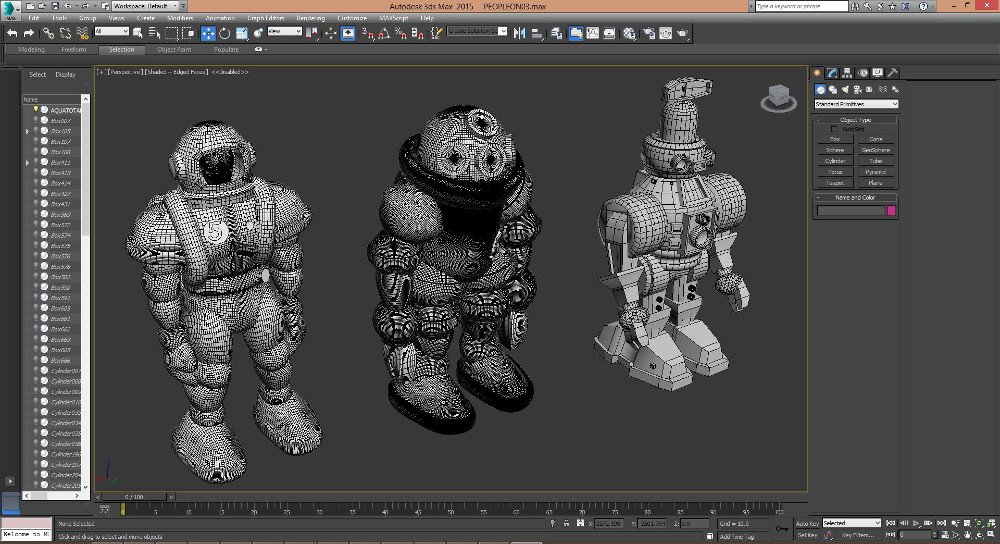5 types of animation which bring stories to life

Whether the term animation reminds you of your favourite childhood cartoon or the anime that you can’t get enough of, it is safe to assume that animation occupies a special place in our heart. If you want to translate this love into creating your own animation or making a career in it, then read on to find out about different types of animation.
Before we get into the types of animation, let’s briefly understand what animation is.
What is animation?
Animation refers to bringing still drawings or images to life by moving them in quick succession. These images have slight differences which give the illusion of movement to the human eye. The simplest example of this is a flipbook.
What are the types of animation?
The enthralling world of animation can be divided into 5 categories:
1. Traditional/cel/2D animation
Tom and Jerry, 101 Dalmatians, The Jungle Book… No, we aren’t taking a trip down the memory lane! These are all examples of the traditional form of animation which uses hand-painted images.
In this type of animation, the animator uses transparent sheets of celluloid plastic to paint the sketch. Due to this reason, it is also called celluloid or cel animation.
This type of animation broadly takes place in the following steps:
1. Create a draft sketch.
2. Trace and ink this sketch on a celluloid sheet.
3. Paint the cel on the other side of this sketch using acrylic paint or gouache. Doing this gives a smooth look to your painting on the front side.
 Source: Nickipedia
Source: Nickipedia
4. Paint a background on another sheet.
5. Place the cel sheet on this background.
6. Take a photograph.
 Source: https://www.cybercomputing.co.uk/ICT/Design/celdesign.htm
Source: https://www.cybercomputing.co.uk/ICT/Design/celdesign.htm
Each drawing is called a frame. Every second of the animation needs 12-24 frames to show the slight changes in movement.
When these frames are played in succession, it gives the impression of 2D movement.
Traditional animation can be a time-consuming technique, so its use has declined. Disney, one of the pioneers of animation, stopped using hand-drawn animation in 2011 with the release of Winnie the Pooh.
Although hand-drawn animation is not common anymore, it is still used in combination with other animation techniques. For example, Cartoon Saloon, an Irish studio, uses the combination of both hand-drawn art and computer-generated animation.
Apart from TV shows and feature films, traditional animation has also been used in the Beatles song ‘Yellow Submarine’ and this advertisement by Berghaus, a UK-based outdoor clothing company:
So, if you are someone who likes the feel of paper when you draw, traditional animation could be the way to go!
2. Digital 2D animation
As beautiful as traditional animation is, you can imagine how painstaking it can be with all the photographs that need to be taken. So, with all the technological advancements, surely they found an easier way to do traditional animation?
Enter digital 2D animation!
 Source: Hypebeast
Source: Hypebeast
Rather than hand-drawing, painting, and taking photographs, the animations are directly drawn on the computer using pen-tablets.
In vector-based 2D animation, the technique of computer interpolation is used to generate images. For example, if you are showing a ball in motion, you can select the starting and ending point for it, and the animation software will create the other images for you. A key ingredient in this animation type is the vector graphic, which is an image that can be increased in size without being pixelated.
Digital 2D animation is used in video games, e-learning, marketing, mobile apps, advertisements, and of course movies! So, most of the animation that you see these days is 2D. This rise in the trend of 2D animation is due to its affordability and accessibility. You don’t need to be in a special animation studio anymore, and you could create it from anywhere!
If you are just getting started, use Flash as it’s easier to pick up on. You will learn about basic concepts such as tweening and keyframing and experience the joy of creating your first animation! Then, once you have worked on those drawing skills, you can move on to the other popular animation software such as Adobe After Effects, TVPaint, and Toon Boom Harmony.
3. 3D animation
In 1995, Pixar came out with the movie Toy Story, which changed the course of animated films. Animation had so far been restricted to the realm of 2D. Toy Story made use of 3D images, which was unlike anything that the world had seen before.
In 2D animation, the characters and backgrounds are flat animations with only length and width like a drawing on a piece of paper. 3D characters, on the other hand, have length, width, and height like real-life objects. These are computer-generated images that are animated digitally.
 Source: 3D Ace
Source: 3D Ace
Yoshiaki Nishimura, a Japanese filmmaker, describes the difference in the following words – “2D animation is an extension of painting, but 3D is an extension of 3D [sculpture] so they’re completely different.”
A 3D animation pipeline consists of the following steps:
1. Script – No matter which type of animation you go for, a good story will always be at the heart of it. So, that’s the first step!
2. Storyboard – Storyboarding refers to drawing important scenes. This process could also be done alongside the writers when they are writing the script.
3. Animatic – Storyboards are then combined with a temporary soundtrack, sound effects, and dialogues to give a rough idea about the story.
4. Concept art – Once the story is finalised, the next step is to conceptualise the characters, costumes, and backgrounds. These concepts serve as a reference for the animators.
5. Character design – Once the initial sketches have been created by the concept artists, character designers define the traits and personality of characters. For example, the facial expressions of a character.
6. Background design – Background designers create different locations that will be a part of the animation. This step requires attention to detail as the background should match the animation style and should not be too distracting.
7. Color scripts – This step involves choosing the color for the animation. As different colors can evoke different emotions, the colors are deliberately chosen.
8. Modeling – The characters finally enter the 3D realm at this stage! Characters, backgrounds, and props are turned into a 3D mesh in a software. This mesh is then sculpted to make it more refined.
Apart from movies, 3D modeling is used in engineering, architecture, and game development.
 Source: 3D printing
Source: 3D printing
9. Texturing – The end product of 3D modeling is a gray 3D model. At this stage, it is given colors and textures that the object is likely to have in real life. For example, a metal surface reflects light, whereas the human skin will absorb some and look smooth.
10. Rigging – The characters are given skeletons, which allow them to move and react like living beings. For example, when you lift your foot, the other parts of your body also react to this movement. This action is made possible in the animation world through rigging. So, controls are added around the face and joints to make this movement possible.
11. Voicing – Once the characters have a shape and form, voicing actors are called in the studio to record the dialogues. These sessions are often recorded so that the animators can use them as a reference while animating the characters.
12. Animation – During the animation process, animators use keyframes to make the 3D models move. In the keyframing process, the animators specify the mainframes and the computers generate the remaining frames. These frames are then further manipulated by the animator to create the correct motion. Animators can also make use of data from motion capture to animate the 3D models.
As you can see, drawing isn’t the most important part of the job. So, if you are just starting out and drawing isn’t your strong suit, you can still animate using 3D animation. Isn’t that amazing?
While animating in 3D, you also need to remember that the character should always show some form of life. Although you can get away with a still drawing for 2-3 frames in 2D animation, this is not possible in 3D as the character would look dead.
Another important part of 3D animation is research. For example, while creating Sully’s character in Monsters Inc., the animators had to observe animals with real fur to understand how different strands move!
13. Special effects – After the animation stage, any special effects such as an explosion are added.
14. Lighting – Much like in photography, light and shadow play an important role in creating a certain mood in animation. For example, in the movie Coco, the different kinds of lights create the magical Land of the Dead.
 Source: Insights Hub
Source: Insights Hub
15. Rendering – This is a critical step in 3D animation as it takes all the data and converts it into images that show this 3D world. It is exported in the form of a video, which the viewers see later. Rendering is a time-consuming process and can even take months in the case of feature films.
16. Music and sound effects – The last step involves adding a soundtrack and any special sound effects.
And, voila! You get the final product. Could the statement ‘you can’t rush art!’ be more true?
3D animation is currently the most popular animation for feature films. So if you want to break into the filmmaking industry, then 3D is definitely worth spending time on. To start exploring 3D animation, you can check out Blender, which is a free software for 3D. Other industry-standard software include Maya, Blender, Cinema4D, and 3DSMax.
Stop motion
Now let’s find out about the animation behind Pingu, Bob the Builder, and Shaun the Sheep!
Stop motion is similar to the traditional animation style. Instead of hand-drawing and painting, animators use photographs of real objects like clay, cut-outs, puppets, etc. These objects are moved slowly, and pictures are taken for each frame. For instance, if you are trying to show a moving person, you will have to make multiple models of this object that show different movements such as lifting the right leg, lifting the left leg, etc., and then replace them for each scene.
So stop motion, as you can now imagine, requires you to stop a lot to create motion. However, you get to be around tangible art all day!
Besides creating adorable cartoons such as Pingu, Shaun the Sheep, and Bob the Builder, stop motion is used in advertisements. For example, this short film ad by Stayzilla.
Motion Graphics
Motion graphics blends together the world of graphic design and animation. It includes any text or abstract shapes that you see moving on a screen. For example, title sequences of movies or shows. They show visuals and credits in a manner that sets the tone and mood for the show. For example, the animated title sequence for the movie Catch Me If You Can.
Other uses of motion graphics include creating company logos and making company presentations to simplify complex information with the help of visual aid. They are also used to draw more attention to a particular part of a website or app.
Which animation type should you learn?
The animation industry has something for every type of animation enthusiast. So, you can begin with any animation that you find engaging. If you want to break into the filmmaking industry, then the primary skill that you need is storytelling or how Pixar has put it in their job description of an animator:
“We want you to be able to bring the character to life, independent of medium.”
However, if you want to explore animation beyond the realm of movies, then you can become an animator in the fields of marketing, advertising, medicine, architecture, engineering, and augmented reality (AR).
If you are ready to bring your imagination to life, you can check out Internshala’s Animation training and get started! Use coupon code BLOG10 to get a discount of 10%.



